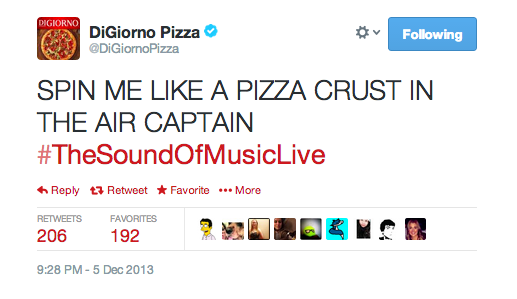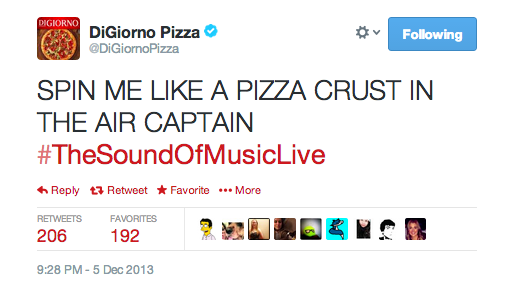
DiGiorno Pizza brand execs were initially dubious about Twitter. The brand wanted to challenge the big boys of pizza, Domino’s, Pizza Hut and Papa John’s, and doing that 140 characters at at time didn’t seem like it was worth it.
The frozen-pizza brand’s agency, Resource, advocated exploring the medium a bit farther. For the past year, it has embarked on an experiment to figure out how DiGiorno’s could find its niche on Twitter. In due course, over fits and starts, it settled on who it was: a wise-cracking couch potato who likes to make snarky comments while watching sports and even “The Sound of Music.”
“It’s the guy sitting next to you on the sofa,” Lora Schaeffer, vp of social at Resource, said during a presentation at the Digiday Agency Summit in Palm Springs, Calif. “We really cracked the code on who DiGiorno was. It took a year to find our voice and find our footing, and do it in a way that consumers are excited about and want to participate with.”
Here are some key lessons learned that Schaeffer shared during her talk:
It’s not all about real time.
For all the talk of “Oreo moments,” the key is to pick your spots.
“It’s less about being there all the time and having content all the time. It’s about how do you get someone’s attention, how do you keep someone’s attention and how do you entertain.”
Know your audience.
DiGiorno’s is talking to 19-28-year old men. That meant an experiment in “smack talk” during football games in the fall, using the hashtag #noyoudidnt.
“Even when we’re talking to mom, who might be buying the pizza, she appreciates that this tone sounds like the person she’s buying the pizza for.”
Seize cultural moments.
In December, NBC broadcast “The Sound of Music.” It wouldn’t seem like the ideal cultural event for a pizza brand targeted to young men. But Resource noticed that the chatter was going well beyond fans of musicals. So it jumped in to live-tweet the broadcast, keeping with its snarky tone — and in the process winning plaudits and new fans of its irreverent approach.
“It was about how do we find those moments or conversations and influence them. We’re talking about small and limber teams. They’re focused on a brand, they’re on Twitter and who are watching what’s going on in the world and figuring out ways to insert the brand.”
Measure what you can.
Social media ROI is a hot topic for everyone. It’s not easy to draw a straight line to sales, but there are ways to work to get there.
“We’re seeing purchase intent go up. We see people post pictures of DiGiorno’s in their shopping carts to Twitter and Instagram saying they’re buying it because they follow us on Twitter. We’re starting to build the analytics.”
See a five-minute clip of Schaeffer discussing the DiGiorno approach to Twitter below.
Case Study: Ruling In Real-Time from Digiday on Vimeo.
More in Marketing

Why the New York Times is forging connections with gamers as it diversifies its audience
The New York Times is not becoming a gaming company. But as it continues to diversify its editorial offerings for the digital era, the Times has embraced puzzle gamers as one of its core captive audiences, and it is taking ample advantage of its advantageous positioning in the space in 2024.

Why B2B marketers are advertising more like consumer brands to break through a crowded marketplace
Today’s marketing landscape is more fragmented than ever. Like consumer brands, business brands are looking to stand out in a crowded and competitive marketplace, making marketing tactics like streaming ads, influencers and humorous spots more appealing.

As draft puts WNBA in spotlight, the NBA is speeding up ballplayers’ transition to creators
The NBA’s star athletes are its greatest marketing asset.






